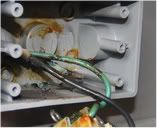I was down working on my boat today and had a shop light and electric drill (with a wire wheel on it) plugged into the 110v outlet that is in my bilge. It is a standard Sea Ray install... came with the boat. The plug is wired to a GFI up in a locker in the cockpit and then to the electrical panel inside with a 15A breaker. All seems good... remember that the boat is diesel so it's ok to put a plug in the engine room.
So I'm working today and the light goes out and the drill stops. The GFI won't reset so I thought the GFI was toast and went and bought a new one and installed it... worked... but still no power to the plug in the bilge. I pulled the cover off the 110v plug and OUCH!

The plug is melted where the white wire attaches. I should say "was attached" as it was burnt right off the thing. If you look closely at this wire, the thing was stripped back about 2" instead of being flush into the fitting like the black and green wires... Very poor install job.

This exposed wire was very corroded as see with the green copper oxide on the wires. It was actually stuck to the bottom of the electrical box and it appears moisture had gotten in this thing and the bare wire sat in it and corroded. Note there is nowhere for the moisture to drain in that set up...
I actually used to use this plug to drive two XTreme boat heaters in the winter. I now have Wolverine oil pan heaters and a single XTreme but they are hard wired into the panel now. I'm lucky this thing didn't catch the boat on fire.
I think this is a great example of why you don't want to put a 110v plug into a gas engine room to run boatsafe type heaters (or battery chargers, etc.). Any corrosion on the wires and BOOM! It also shows why any 110v splices need to be in properly rated UL boxes and not just left in the open with some shrink wrap on them.
The weekend is here... needed some controversial topic to discuss. Like a non-GFI plug installed in a gas engine room and a battery charger plugged into it (i.e. a "cool mod" we should all remember)...
I'm going to run a new 12g wire circuit to this plug tomorrow and rotate it so moisture can drain out the bottom at the strain clamp...
So I'm working today and the light goes out and the drill stops. The GFI won't reset so I thought the GFI was toast and went and bought a new one and installed it... worked... but still no power to the plug in the bilge. I pulled the cover off the 110v plug and OUCH!

The plug is melted where the white wire attaches. I should say "was attached" as it was burnt right off the thing. If you look closely at this wire, the thing was stripped back about 2" instead of being flush into the fitting like the black and green wires... Very poor install job.

This exposed wire was very corroded as see with the green copper oxide on the wires. It was actually stuck to the bottom of the electrical box and it appears moisture had gotten in this thing and the bare wire sat in it and corroded. Note there is nowhere for the moisture to drain in that set up...
I actually used to use this plug to drive two XTreme boat heaters in the winter. I now have Wolverine oil pan heaters and a single XTreme but they are hard wired into the panel now. I'm lucky this thing didn't catch the boat on fire.
I think this is a great example of why you don't want to put a 110v plug into a gas engine room to run boatsafe type heaters (or battery chargers, etc.). Any corrosion on the wires and BOOM! It also shows why any 110v splices need to be in properly rated UL boxes and not just left in the open with some shrink wrap on them.
The weekend is here... needed some controversial topic to discuss. Like a non-GFI plug installed in a gas engine room and a battery charger plugged into it (i.e. a "cool mod" we should all remember)...
I'm going to run a new 12g wire circuit to this plug tomorrow and rotate it so moisture can drain out the bottom at the strain clamp...
Last edited:





